Soft, silken, creamy Egg Tofu made with eggs and dashi. It is steamed, chilled, then served with savory dashi broth. Enjoy the refreshing flavors while it quickly melts away in your mouth.
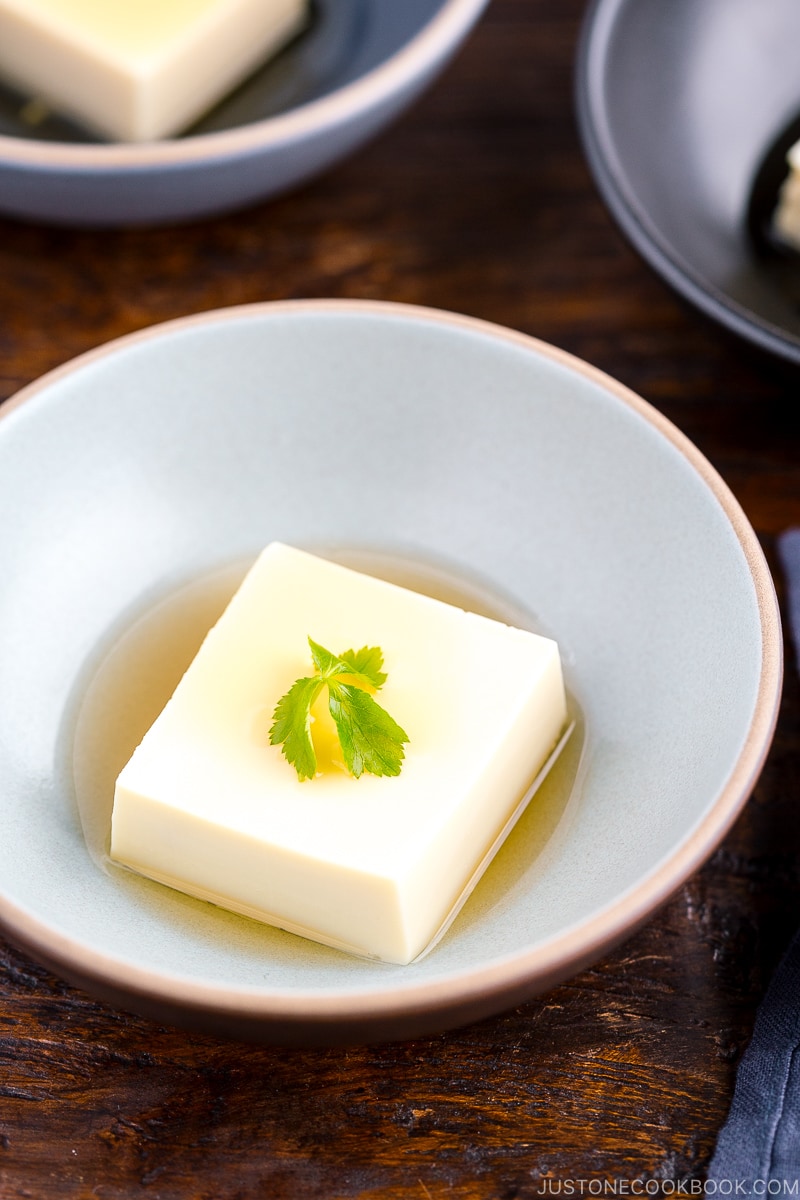
The popular Japanese TV program called Shinya Shokudo (深夜食堂) or ’Midnight Diner: Tokyo Stories (Season 1)‘ is now available on Netflix. The show features Japanese diner/home cooking recipes that are not your standard Japanese food served in restaurants in the U.S.
Since the drama doesn’t provide detailed ingredients and step-by-step instructions, I’ll be sharing these copycat recipes on my blog. Today’s recipe is Egg Tofu (玉子豆腐).
What is Egg Tofu?
Egg Tofu is Japanese steamed tofu made of eggs and dashi mixture that is steamed till firm, chilled, then served with a dashi and soy sauce broth. In Japan, we call this dish Tamago Dofu (玉子豆腐).
Even though it’s called “tofu”, egg tofu does not include soybeans or nigari. What is nigari? It is magnesium chloride which is used to firm soymilk into silken tofu. The dish is called egg tofu because of its tofu-like texture and square shape, just like Sesame Tofu (胡麻豆腐) and Almond Tofu (杏仁豆腐) which also do not contain soy.
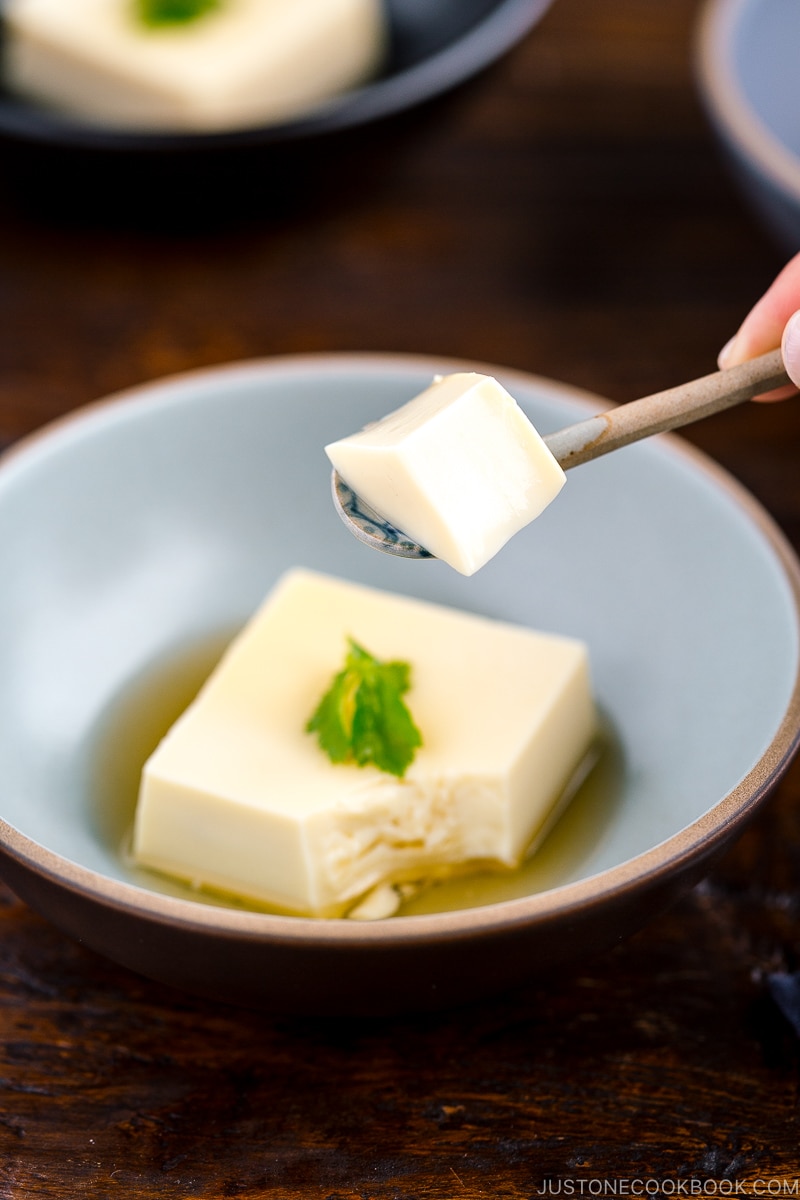
Tips for Making Egg Tofu
1. Egg to Dashi Ratio
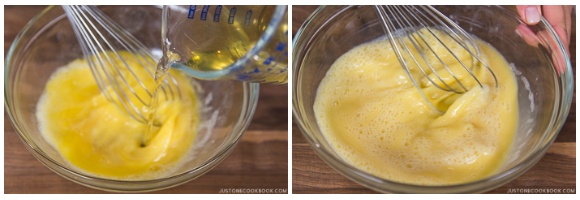
Usually, egg to dashi radio is one to 1.5 – 2. If I use 4 eggs (roughly 200 grams; American large egg is about 50 grams each without shell), you’ll need 300 – 400 grams/ml dashi to achieve smooth, silky texture of egg tofu. The higher the dashi texture is in the egg mixture, the silkier it gets.
2. Usukuchi Soy Sauce vs. Regular Koikuchi Soy Sauce
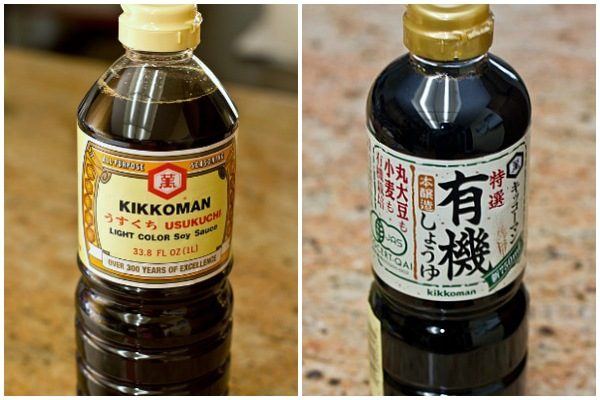
Usukuchi soy sauce (薄口醤油) is a light-color soy sauce, which actually tastes saltier than regular, darker color koikuuchi soy sauce (See my pantry page).
I have to admit I don’t always keep usukuchi soy sauce in my kitchen. Remember my recent Kazunoko (Herring Roe) recipe for New Year’s feast? That would have been lighter in color if I have used usukuchi soy sauce instead of regular soy sauce.
Usukuchi soy sauce is more commonly used in western Japan, such as Osaka. As I grew up in Yokohama (near Tokyo), I’m used to using dark-colored broth in my udon noodle soup made with regular soy sauce. Regular koikuchi soy sauce is also more common and available to purchase everywhere.
However, with dishes that you want to maintain the ingredients’ natural color, I highly recommend usukuchi soy sauce. For example, when you make egg tofu and chawanmushi (savory steamed egg custard), you want to keep a light and creamy yellow color. So you would use usukuchi soy sauce to keep this appetizing beautiful color with light-color soy sauce.
So, may I encourage you to get usukuchi soy sauce?
3. Steaming Egg Tofu to Perfection
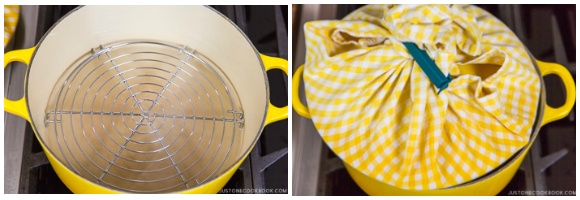
Even though “steaming” is a fairly simple cooking method, when you cook egg tofu, you can’t just put the food in the steamer, cover, and wait till it’s done. If you do this, the temperature in the pot could be too hot and you will overcook the egg tofu.
The pot can’t have too much steam (resulting in high temperature), as it will lead to the protein being hardened and solidified. You can still eat it, but it will result in tiny holes on the inside and the surface of the egg tofu. In Japanese, we call this “Su ga tatsu (すが立つ)”.
To avoid this unpleasant texture in tofu from happening, you have to make sure the pot is not too hot. You can easily do this by leaving the lid ajar and reducing the heat to the lowest possible, making sure that inside the steamer is less than 194F (90C). The trick for this dish is to cook slowly on low heat.
Make sure to cover the lid with a large kitchen towel so condensation won’t drop and ruin your egg tofu. I also figured out a new trick. It was a bit harder to take it out the hot stainless steel Nagashikan (ramekin). If you place the cloth underneath and sides, you can easily pull up using the cloth. This also prevents the stainless steel from getting too hot on the bottom.
As my bamboo steamer didn’t have enough height for my egg tofu ramekin to go inside, I used a 5 1/2 QT Le Creuset Dutch oven and a 8 5/8″ round cooling rack as a steamer.
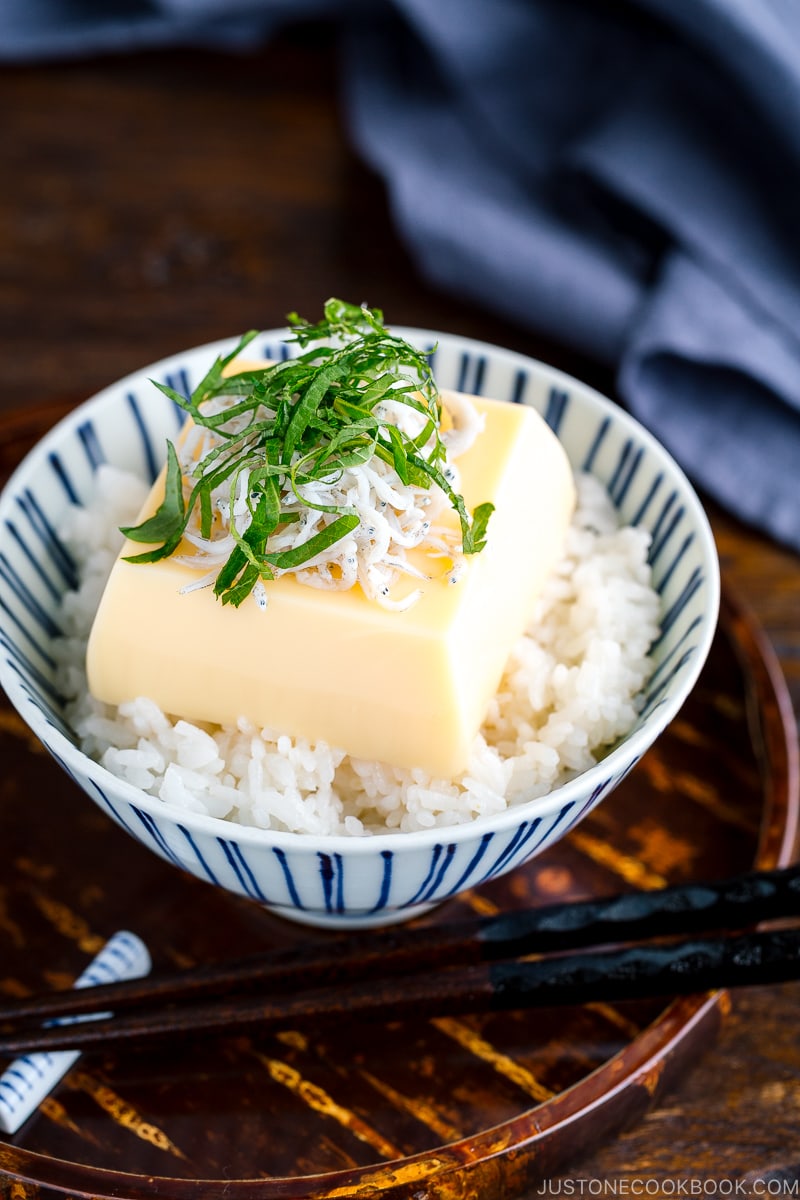
How To Make ‘Midnight Diner’ Egg Tofu on Rice
In Episode 5 of ‘Midnight Diner: Tokyo Stories” Season 1, the egg tofu is served on steamed rice. I’ve never tried eating egg tofu over rice, so I attempted after watching this episode. To my surprise, it was very delicious and so easy to make! Here are the main ingredients:
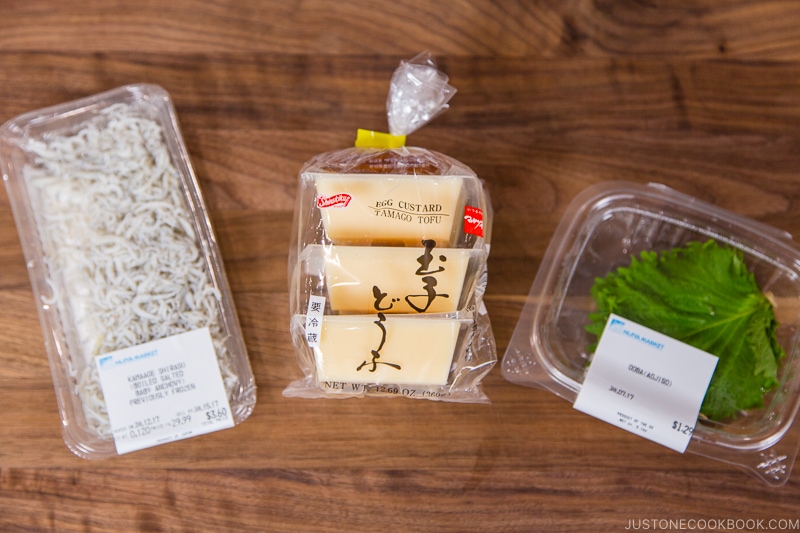
From left, kamaage shirasu (boiled baby sardines), egg tofu, and shiso leaves. For making egg tofu from scratch, follow today’s recipe below.
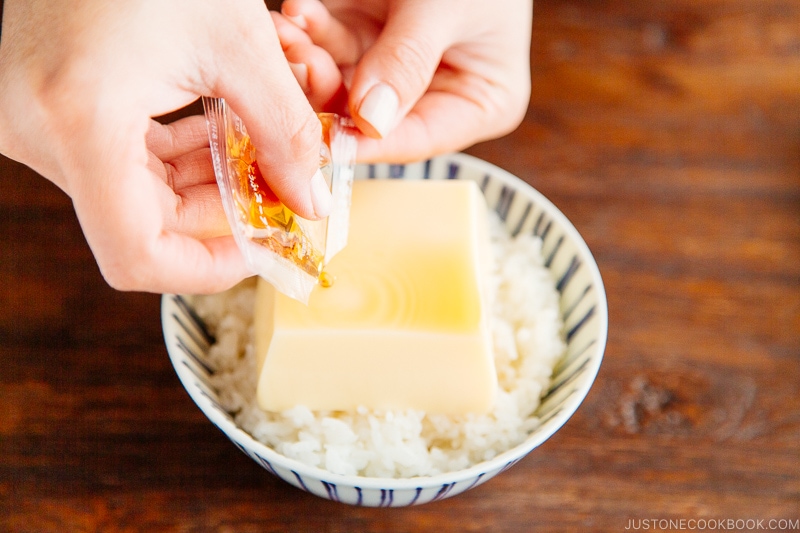
Serve steamed rice in your rice bowl and place the egg tofu on top. Pour the sauce that comes with the egg tofu package (or homemade sauce I provided in today’s recipe). Then place the shirasu (no need to rinse) and shiso on top. And that’s it!
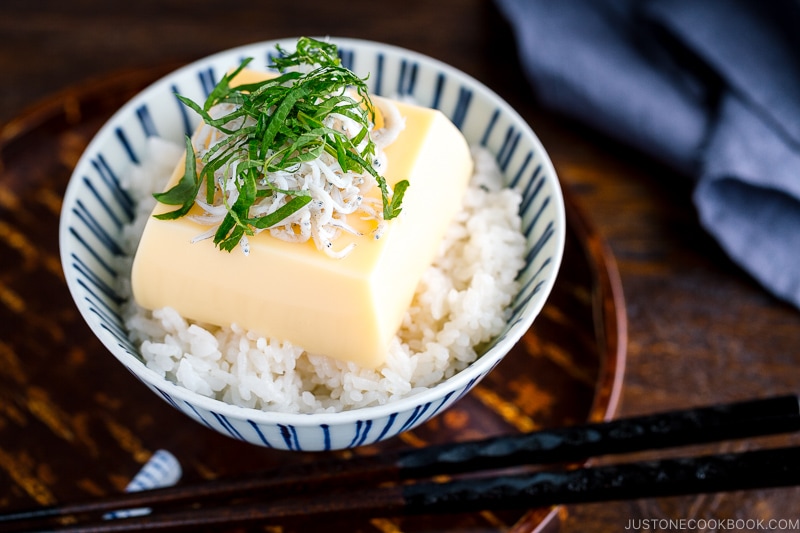
Delicious Egg Tofu on Rice, just like the one you saw in ‘Midnight Diner’. This humble dish really surprised us. Personally, I was surprised how the saltiness from shirasu and refreshing shiso flavor worked so well together in this recipe.
As shirasu and shiso are unique ingredients and often hard to find outside of Japan, you may eat egg tofu on rice by itself or enjoy egg tofu as an appetizer. The dashi poured over the egg tofu is really delicious, so you will enjoy this dish either way.
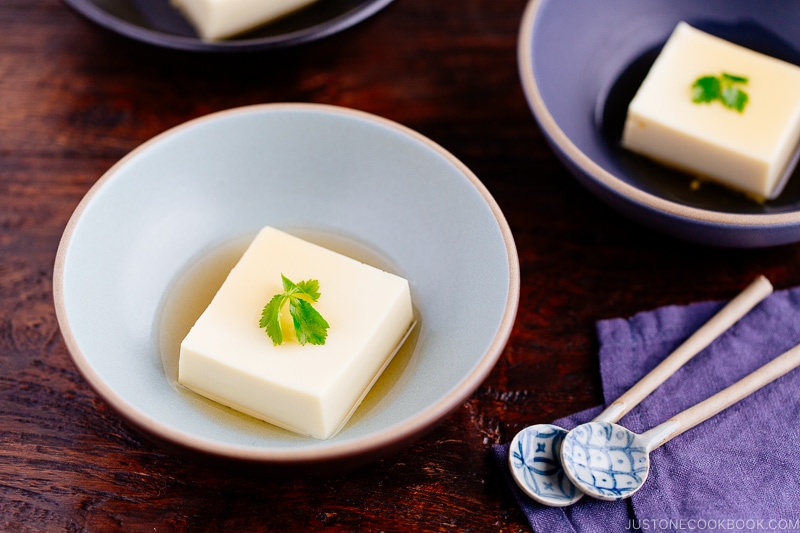
Sign up for the free newsletter delivered to your inbox and stay in touch with me on Facebook, Pinterest, YouTube, and Instagram for all the latest updates.
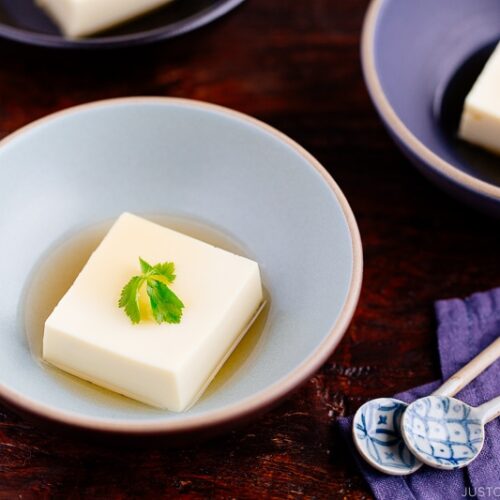
Egg Tofu (Tamago Tofu)
Ingredients
- 4 large eggs (50 g each w/o shell)
- 1¼ cups dashi (Japanese soup stock) (use standard Awase Dashi, dashi packet or powder, or Vegan Dashi)
- 2 tsp usukuchi (light-colored) soy sauce
- ⅛ tsp Diamond Crystal kosher salt
For the Sauce
- 2 Tbsp mirin
- 150 ml dashi (Japanese soup stock) (⅔ cup minus 2 tsp)
- 1 Tbsp usukuchi (light-colored) soy sauce
For the Toppings
- mitsuba (Japanese parsley) (optional)
Instructions
- Gather all the ingredients. Set up a steamer with water in the pot. Bring it to a boil, then turn off the heat and keep the lid on. I use a nagashikan (egg tofu ramekin). You can buy it on Amazon (finally they have one!) You can also use a square/rectangular container or individual bowl such as chawanmushi cups.

To Make the Sauce
- In a small saucepan, bring 2 Tbsp mirin to a boil and let the alcohol evaporate. When the alcohol smell disappears (after 10–15 seconds), add 150 ml dashi (Japanese soup stock) (⅔ cup minus 2 tsp).

- Add 1 Tbsp usukuchi (light-colored) soy sauce and bring it to a boil. Once it‘s boiling, turn off the heat and set aside.

To Make the Egg Tofu
- Crack 4 large eggs (50 g each w/o shell) into a bowl and whisk well. Add 2 tsp usukuchi (light-colored) soy sauce, ⅛ tsp Diamond Crystal kosher salt, and 1¼ cups dashi (Japanese soup stock).

- Strain the egg mixture through a fine-mesh sieve to achieve a silky, fine texture. I believe this step makes a huge difference in the final result.

- Quickly rinse the nagashikan or ramekin under cold running water. Pour the egg mixture into it.

- Scoop away the small bubbles on the surface with a spoon. Place the nagashikan or ramekin on a steamer* rack. Tip: After trying this recipe a few more times, I figured out a new trick. It was a bit difficult to remove the hot stainless steel nagashikan from the steamer. However, if you line the bottom and sides of the steamer with a cotton cloth, you can easily use it to pull up the egg tofu ramekin. This also prevents overheating the bottom of the nagashikan from the heat beneath. * As my bamboo steamer didn‘t have enough height for my egg tofu ramekin to go inside, I used a 5½ QT Le Creuset Dutch oven and an 8⅝" round cooling rack as a steamer.

- Close the lid wrapped with a large kitchen towel; otherwise, the condensation collecting on the lid will drop onto your Tamago Tofu and ruin it. Leave the lid slightly ajar so it won't get super hot inside the pot but just hot. Steam on the lowest heat possible on the stove for 20 minutes, or until a skewer inserted comes out clean.

- Once it’s done, take the ramekin or nagashikan out of the steamer immediately. Let it cool completely on the countertop and chill in the refrigerator for 2 hours. If you plan to serve immediately, place the nagashikan in an ice water bath to cool.

- Run the knife along the edges of the nagashikan and slide out the Tamago Tofu.

- Cut into 4 to 6 pieces. Transfer to a serving plate/bowl. Pour the sauce and garnish with mitsuba (Japanese parsley) (if using).

To Store
- Store in the refrigerator for up to 2 days. You can‘t freeze Tamago Tofu as the texture will change.
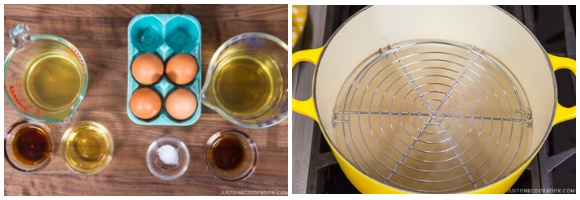
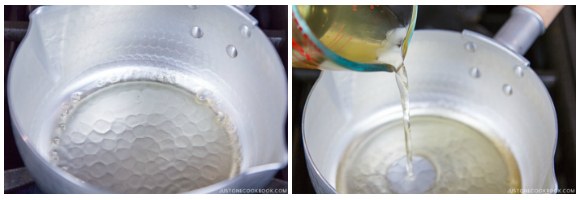
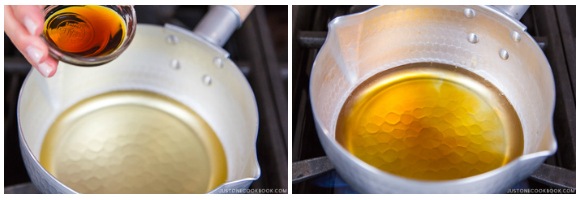
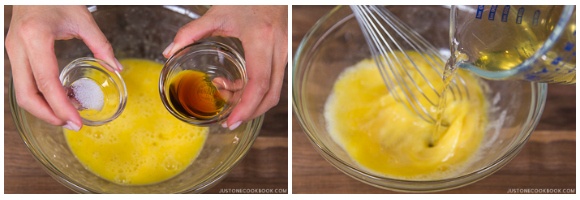
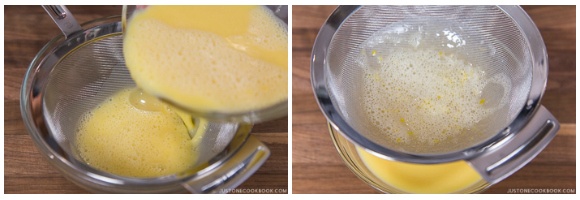
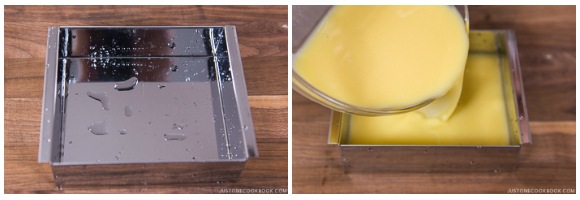
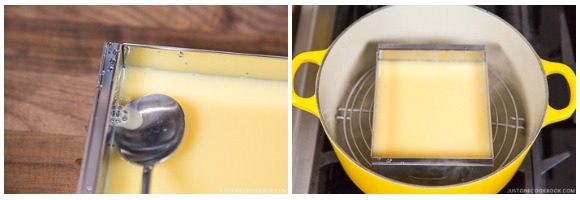
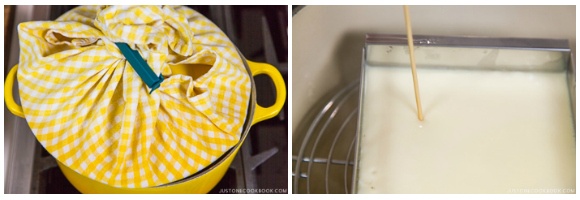
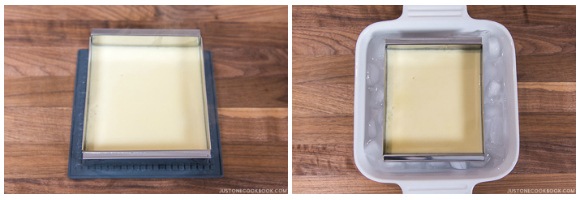

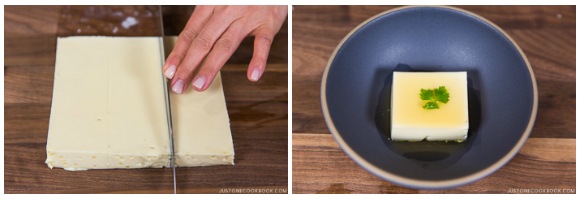










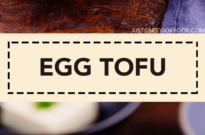
Love this recipe! I have been trying to get creative with eggs since my husband and I gym rats and we live by our macros. I see you included the nutrition information (amazing thank you!) but the only thing that is missing is the serving size by grams? How many grams is a serving size in your recipe?
Hello, Ashley! Thank you so much for your kind words regarding Nami’s recipes!
The nutrition information is approximate, and each serving is divided by the total number of servings on each recipe card. Because we do not weigh each final dish, we cannot provide the weight in grams. Thank you for your understanding.😊
We bought pre-made Tamago tofu at the local Japanese market for the first time today and I was obsessed, so came straight to JOC and of course wonderful Nami has the recipe!
Came to share…
1. I just ordered the equipment on Amazon with your link – but had to order a different rack for the Dutch Oven as the link you have is no longer available – there are others, but you won’t get affiliate credit, sorry!
2. We didn’t have Japanese parsley, so we sub’d spring onion/scallion tops chopped fine (like we’d put on silken tofu) and it was AMAZING! Highly recommended.
Will update as soon as we make from scratch!
Hello, Rebecca! Thank you so much for taking the time to read Nami’s post and sharing your experience with us.
We hope you enjoy making homemade tamago tofu soon. Happy Cooking!
Do you recommend the store bought egg tofu in your picture?
Hi Anna, Thank you for reading Nami’s post.
Homemade is best, but yes, the one in the picture is good in the US.
We hope this helps!
Hello! I’m coeliac, so need to cook gluten-free. How would using tamari instead of usukuchi change the dish? Or is there a GF alternative other than tamari that can be used? Thank you!
Hi Seth! Thank you so much for reading Nami’s post and trying her recipe!
Tamari is thicker and darker in color than Usukuchi soy sauce. As a result, the dish will be darker in color.
In terms of other GF options, we believe this is the only GF soy sauce available at the moment.
Thank you!
Hello, in the dashi recipe linked, there are quite a few types of dashi, which one would be best for this recipe?
Hi John, Thank you very much for reading Nami’s post and trying her recipe!
Any type of Dashi would work great for this recipe, but Awase Dashi is very good.☺️
https://www.justonecookbook.com/how-to-make-dashi/
We hope this helps!
[…] usually fermented in a brine made from milk and meat. And, "egg tofu" contains eggs. (Fun fact: Japanese Egg Tofu isn't usually made with soy/tofu, it just has a similar […]
If I didn’t care about the looks, would a ceramic ramekin work and line with cheesecloth to pull it out?
Hi Terri! Thank you very much for trying Nami’s recipe!
Yes. You can use ceramic ramekin to make this dish, but we have never pulled it out using cheesecloth. It sounds possible…
Another idea is to serve the Egg Tofu with ceramic ramekin.
Can you substitute ceramic ramekins if you don’t have the Nagashikan?
Hi Jennifer! Yes. It should work.
However, The Nagashikan is easy to take out the Egg Tofu. You might need to serve the Egg Tofu in the ramekins without taking them out if you use ceramic ramekins.
And please adjust the cooking time. We hope this helps!
What a wonderful idea! When I watched the Midnight Diner I often looked up the dishes they mentioned online, so it’s so great to have the full recipe with explanation from you!
Hi Joanna! Thank you very much for reading Nami’s post and for your kind feedback!
Currently, Nami has Midnight Diner season 1 and 2 recipes here on our website! We hope you enjoy them too. Happy Cooking!
https://www.justonecookbook.com/netflix-midnight-diner-tokyo-stories-season-1-recipes/
https://www.justonecookbook.com/netflix-midnight-diner-tokyo-stories-season-2-recipes/
I tried this recipe and it works. I used omega eggs instead of normal eggs and it came out heavenly. I also used Royco (Indonesia’s Knorr) as a replacement for the dashi and the soy sauce? I used fish sauce (which makes it taste like shrimp). For the mirin, I didn’t use any, because me and my family are Muslim, we can’t drink alcohol, I used the replacement for mirin, which is 3 parts water to 1 part sugar, and it came out just fine! Also for me, the sauce you put on top of the tofu? It’s sickeningly sweet! I had to adjust the taste to our liking (salty and hot). Nevertheless, this is a great recipe for beginners and home cooks alike.
Hi Muhammad, Thank you very much for trying this recipe and sharing your cooking experience with us!
We are glad to hear it turned out well for you.☺️
Great recipe!! I can not wait to try it out! I really love traditional soy milk tofu, but this one seems delicious too. Just a question, is it necessary to eat it right away? Or can I cut it into serving size pieces and freeze it?
Thank you really much!
Hi Maexei! Unfortunately, this recipe is not designed for freezing to store because the texture will change. Hope you enjoy(ed) the recipe! 🙂
[…] seafood fare enjoyed in Japan. They make an excellent topping on Chilled Tofu (Hiyayakko) and Tamago Tofu. Sometimes we mix them with rice or rice balls, or make Furikake. We also preserve the fish by […]
[…] enjoyed in Japan and eaten by themselves, used as a topping on Chilled Tofu (Hiyayakko), and Tamago Tofu, mix with rice or rice balls, cooked for Homemade Furikake, or simmer to preserve for later […]
[…] Tamago Tofu (Egg Tofu) […]
[…] use nagashikan to make Tamago Tofu (玉子豆腐) and traditional cold treats like Yokan (羊羹, azuki bean […]